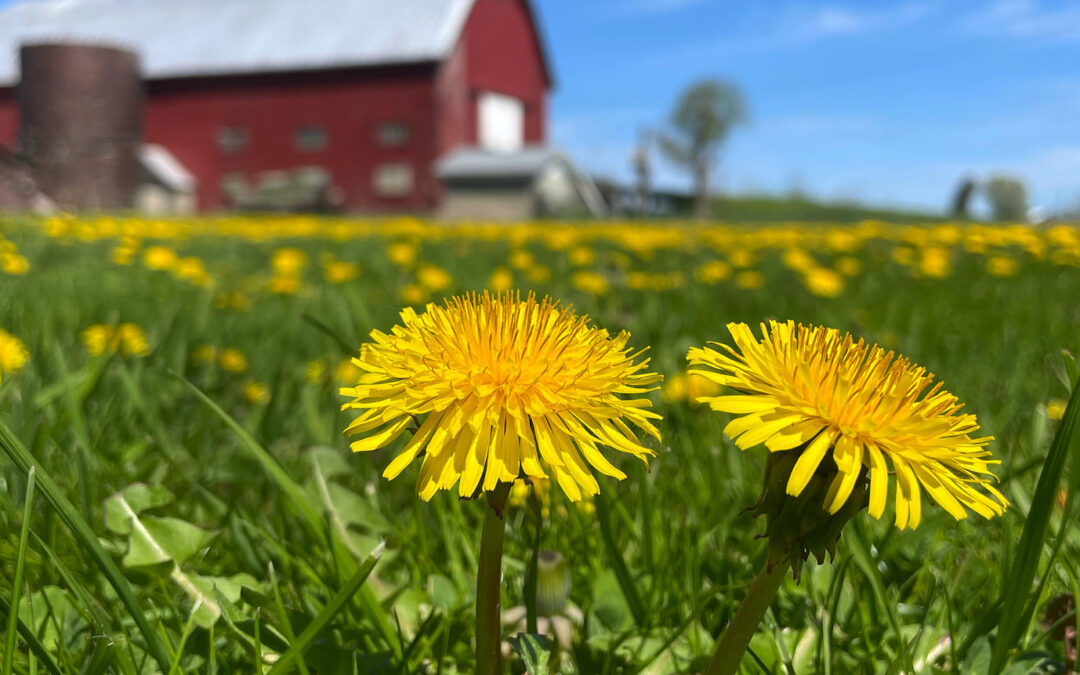By Taylor Brennan, Nature Educator
For many of us, spring is a time where sniffles plague our outdoor adventures. Commonly known as seasonal allergies, the air is filled with particles of pollen, finding its way to our noses and sinuses. We may choose to take a plethora of pills, leaving us feeling drowsy and with time-sensitive relief.
Shifting our medicine from “over-the-counter” to using the plants we have growing in our backyard has changed the way bodies react to the overwhelming pollen we experience. For centuries, before the convenience of pharmacies and breakthroughs of science, civilizations relied heavily on plants and herbs that were used in medicinal ways. Ranging in using Stinging Nettles for pain relief from arthritis to applying Aloe Vera as a way to reduce discomfort from a sunburn, these plants have long been applied as natural remedies that we still use today.
One aid for allergies may be using honey made from local pollen. Better yet, creating our own golden goodness from the plants we are exposed to the most will benefit us. Not only does dandelion honey, a golden syrup made from dandelion petals, have medicinal qualities, it makes for a great family project and a delicious treat. It also brings about a creative way of using backyard weeds in a constructive and mindful way.

Many have returned back to the idea of using our local wild plants to create our own medicines, including the iconic yellow petals from dandelions. These flowers are frequently mowed down and removed when homeowners begin landscaping what has been untouched throughout the winter months. The next time you decide to bring out the weed whacker, think twice before cutting down your dandelions. They are a great source of local pollen and nectar for bees who are looking to fuel the creation of their honey and a means of pollinating other plants. Additionally, dandelions are widely available for us to use. We can make our own honey at home, all while using the weeds that are growing right in our backyards.
By giving our immune systems light exposure to allergens such as pollen, some studies and individuals say we potentially building up antibodies to help better tolerate the reaction we so often get. Stuffy noses, watery eyes, headaches, and sinus pressure are all greatly uncomfortable and can last for weeks through this season. Slowly building a tolerance to pollen involves directly exposing our bodily systems to the allergen bit by bit. Using honey made from plants that are found around where you live can be purchased at local farm stands or markets as well.
When honey and syrups are made in a kitchen instead of a beehive, it is processed differently through means of boiling versus pollen airborne directly from the plant. The boiling and cooking process diminish the severe impact it has on our allergies, which makes local honey a way to slowly introduce these allergens to our immune system.
Below, you will find a recipe I have found successful when making dandelion honey at home. Once made, adding a spoonful to your coffee or tea of choice once a day is not only delicious, but could also be way to start building an immune-based resistance to allergies.

Homemade Dandelion Honey Recipe:
Materials and Ingredients:
Freshly pulled dandelions
Water
Sugar
Saucepot
Mesh strainer
Vanilla extract
Coffee filter/cheesecloth
Steps:
- Begin by venturing into your backyard or natural property where dandelions are plentiful. I would recommend staying away from any public parks, as we don’t know what may have walked there or has pesticide applications. Bring a bowl or large mason jar with you, start pulling the heads of the dandelions and placing them into the container.
- After you have collected your dandelions, you will need to remove the yellow petals inside the flower itself. This can take some time, so I recommend bringing friends or family members to join. Place the yellow petals in another container, separate from the green outer leaves and stems.
- Next, you need to measure the amount of petals you have collected. I recommend anywhere between 3 – 4 cups of petals.
- Soak the petals in a bowl of cold water for a few minutes. This allows any insects that have been in the flowers to escape before boiling. After, place the petals in a mesh strainer and drain the excess water.
- Fill a saucepan with 4 cups of water, add the dandelion petals, a drop of vanilla extract, and place on a low simmer for 30 minutes.
- Remove from heat and allow the mixture to sit, covered, for 6 hours. This gives time for the color, flavor, and pollen to be extracted from the petals and into the water.
- Once the mixture has had time to settle, strain the petals through a coffee filter or cheesecloth. These can be composted or tossed outside, as now you will only need the liquid mixture that you have made.
- Return the mixture to the saucepan and apply low heat. Once it is at a low simmer, you may begin slowly adding in the sugar. Stir occasionally. Over time, the sugar will begin to caramelize, creating a thicker consistency. This may take up to 30 – 45 minutes of stirring and adding in the sugar.
- Once your honey is at the desired thickness and cooled, you may begin pouring into containers that have tight seals. Keep in a refrigerator until you are ready to enjoy!
Audubon Community Nature Center builds and nurtures connections between people and nature. ACNC is located just east of Route 62 between Warren and Jamestown. The trails are open from dawn to dusk and birds of prey can be viewed anytime the trails are open. The Nature Center is open from 10 a.m. until 4:30 p.m. daily except Sunday when it opens at 1 p.m. More information can be found online at auduboncnc.org or by calling (716) 569-2345.
Featured image: Photo by Taylor Brennan


Recent Comments